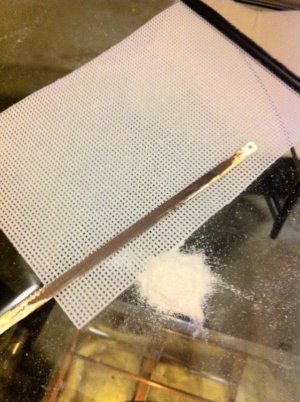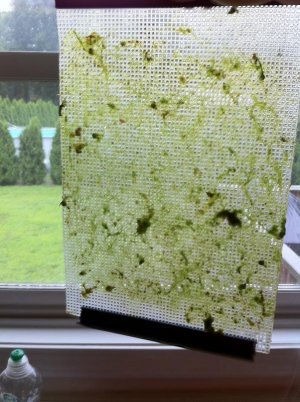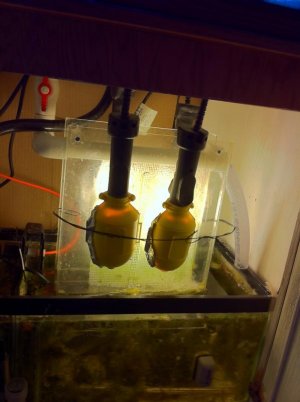Here is some info on copper from another site:
The copper based anti-parasitic treatments like Seachem Cupramine (the best IMO) appear to be safe to use with algae scrubbers. The copper seems to suppress/kill slime algae on the screen, but allows more beneficial algae to grow instead. If you have a lot of slime algae on the screen, rinse it off under a shower first before starting treatment, or expect an ammonia spike (DO NOT USE PRODUCTS LIKE SEACHEM PRIME WHILE TREATING WITH COPPER - they break down the copper into more dangerous forms as they are a reducing agent (e.g. anything that says it removes ammonia))
You will need to test the water every day for copper content (make sure you get a good test kit that has a reference test too (e.g. the Seachem copper test kit)), the reason for this is that the algae absorbs, and pretty quickly, the copper from the water. Expect a full dose (0.5ppm copper) of Cupramine to be absorbed in 3 days on a standard sized/powered algae scrubber (1w/gal lighting, 1 sq. inch, double sided, per gal screen). Depending on the amount of copper in the water you will need to re-dose to get it to the expected amount, but MAKE SURE YOU TEST FIRST! (double check this with the manufacturer of your treatment FIRST! This was however, Seachem's advice).
Part of this is then proven incorrect
After prolonged use of copper in a tank (12 weeks!) it does appear to affect the algae, it seems to take 3-4 weeks to have a noticeable affect then the good green algae seem to die off.
For shorter uses of 2-3 weeks it shouldn't affect the algae too much, but does still appear to absorb copper from the tank. After this point it seems to be just the darker slime algaes that grow and the green algae doesn't seem to re-grow after cleaning, so the scrubber still works, but at a greatly reduced capacity.
After removing the copper (e.g. using Polyfilters or activated carbon with Seachem's Cupramine) the good algae start to regrow within a matter of a few days, mine was back to full strength (actually much better than normal - probably due to the slightly higher nitrates) after 7-10 days of removing the copper.
So it would appear that copper is not totally scrubber safe, especially if it's used over a prolonged period.
What I would suggest is setting up a scrubber on a non-copper tank and getting it broken in (let the screen slime up and start growing algae for about 4-6 weeks). Then set aside a period of time where the QT system is made copper-free by absorption techniques (copper, pads, etc) and switch the scrubber to the QT system for a few weeks and let it take down the N and P to the desired levels. Depending on how "out of control" the N and P are (that's a relative statement!) it could take a week, it could take longer. It also depends on your scrubber strength and the amount you feed. After the N and P drop down, start adding back the copper to the desired level and watch the scrubber closely. It will likely turn to slimy algae (not green hair) and will still filter, but will not be as effective; how much it will be affected is not really known. I think you would be one of the first to run a scrubber on such a system.
The safe bet is to make the scrubber stronger than it needs to be. But you're already 900 gallons so I think oversizing it is not a good option.
Here's what I would do. Track how much you feed the system, and convert that into cubes per day. A cube here would be defined as a cubic cm of food, like a Reef Nutrition cube. If you don't feed such food, then take whatever you are feeding them on a daily basis, shred it up fine (like in a blender), strain it, and pour it into a cube form and that will be what you're feeding per day for purposes of sizing the scrubber. A scrubber built properly and lit from both sides should be able to handle 1 cube of food per day for every 10 square inches (dimensions, not surface area) of screen.
I'm assuming that when the fish are in holding, they are not fed huge gobs of food, but more than "sparingly" as they probably are starving coming off the truck. Also assuming a FO or FOWLR system (no corals). With all this factored in, you may be able to get away with a relatively small scrubber compared to the system you have, but you will probably need to be cleaning the screen every 3 or 4 days, max, as you will probably get a lot of dark brown to black slimy algae, which does filter, but can detach more easily if left on the screen too long under high flow.
So if you have information on about how much you feed (and how many fish are typically kept in QT) as well as the copper treatment levels, post them here and we'll go from there. I might throw a few feelers out regarding your situation and try to get some more insight.





